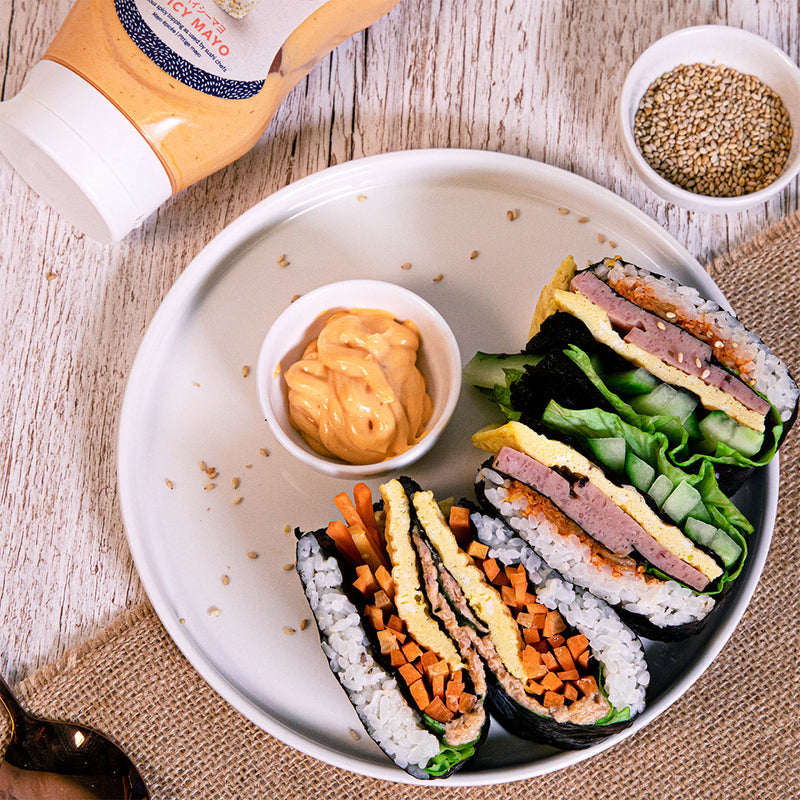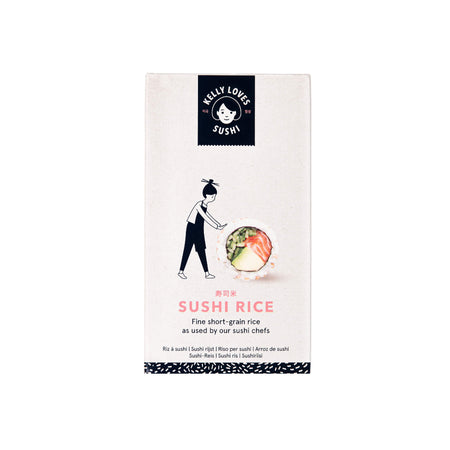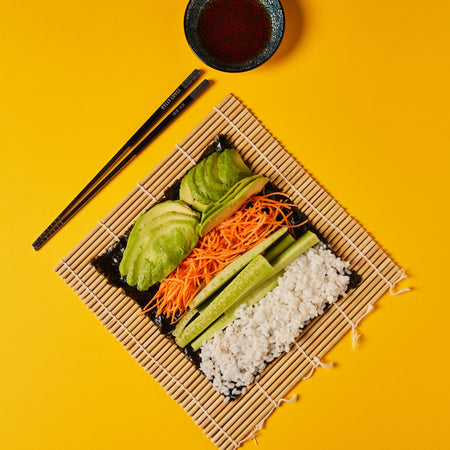8 Easy and Healthy Korean Recipes

If you’re making an effort to eat a healthy diet, it can be challenging to think of new things to cook that are also inspiring. We’ve come up with no less than eight mouth-watering, easy and healthy Korean recipes to add to your repertoire.
Compared to many diets across the globe, Korean cuisine contains a wealth of vegetables, not only in the nutritious main dishes, but also the side dishes. And generally not much oil is used when cooking. But like any cuisine you have to pick and choose the healthiest.
Kimbap (seaweed rice rolls)
Kimbap makes a healthy lunch — just don’t forget to serve it with some kimchi!
Ingredients:
- 400g sushi rice
- 5 nori sheets
- 1 tsp grated ginger
- 250g extra firm tofu
- 1 tsp sesame oil
- 2 tbsp soy sauce
- 1 large carrot cut into thin strips
- 3 large cabbage leaves thinly sliced
- 3 eggs
- 1 tsp grated garlic
- Vegetable oil
- Spicy mayo
Instructions:
- Cook the sushi rice following the instructions on the packet.
- Slice the tofu into 1.5-inch thick batons and leave in a bowl with the ginger, garlic and soy sauce to marinate.
- Add 1 tsp of vegetable oil to a pan and fry the carrots and the cabbage strips for 2 minutes.
- Beat together the 3 eggs. Pour the eggs into the pan to make a very thin omelette. When it’s ready, put it on a plate to cool and cut it into thin strips.
- Add another tsp of oil to the pan and cook the tofu with the marinade — just a minute on each side.
- Place a nori sheet shiny side down on a bamboo sushi rolling mat.
- Spoon some of the sushi rice onto the nori sheet and spread evenly leaving a gap of nori. In the centre of the rice, place your strips of carrot, cabbage and omelette.
- Roll up the sushi using the rolling mat.
- Serve with the spicy mayo to dip!
Mandu (Korean dumplings)
Steam or boil your dumplings rather than fry them for moreish soft pillows, full of flavour.
Ingredients:
- 1/2 of a small cabbage head chopped and parboiled
- 450g minced beef or pork
- 1 small cake of tofu, chopped
- 1 onion, chopped
- 1 teaspoon ground black pepper
- 1 packet of dumpling wrappers
- 2 tablespoons soy sauce
- 3 cloves garlic, minced
- 120g glass noodles (soaked in hot water 15 minutes, then chop up)
Instructions:
- Mix up the cabbage, tofu, onion, minced beef or pork and noodles in a bowl.
- In another bowl, mix the seasonings: sesame oil, soy sauce and garlic.
- Pour the seasoning mixture into the bowl with the meat and veggies and mix.
- Lay out a dumpling wrapper and put about 1 tablespoon of filling in the centre.
- Dip your finger in water and wet around the edge of half of the wrapper.
- Fold the wrapper in half and seal / crimp the edges down.
- Then, you can cook the dumplings by steaming or boiling them.
- Serve with a dipping sauce of your choice.
Gyeran mari (rolled omelette)
You can vary your rolled omelette by adding things like carrots, peppers and kimchi (which also make them a pretty colour).
Ingredients:
- 4 eggs
- 3 spring onions, chopped
- Vegetable oil
Instructions:
- Beat the eggs well in a bowl.
- Add the chopped spring onions to the mixed eggs.
- Heat a little oil in a rectangular skillet. Pour in the eggs. When it’s cooked on one side, fold it in half. Then fold it over to the other side. Repeat the process with the remaining egg mixture until you reach the end of the pan.
- Move the rolled omelette to a plate to cook.
- Shape the omelette into a rectangle on a bamboo mat, then slice bite-sized pieces and serve on a plate.
Cucumber kimchi (oi kimchi)
If you’re a nappa cabbage kimchi fan (tongbaechu-kimchi), this is a refreshing variation.
Ingredients:
- 500g mini cucumbers, halved lengthways
- ½ apple, grated
- 3 spring onions, shredded
- An inch piece of ginger, shredded
- 3 cloves garlic, sliced
- 2 tsp sea salt
- 2 tbsp gochugaru
- 1 tbsp soy sauce
- 1 tbsp fish sauce
- 1 tsp caster sugar
Instructions:
- Put the cucumber pieces into a bowl and sprinkle the salt over them. Mix and leave for 20 minutes to draw out the moisture. Then drain.
- Mix the apple, gochugaru, garlic, ginger, sugar, fish sauce and soy sauce together in a bowl. Add in the drained cucumbers and spring onions and mix again.
- Pour the mixture into a shallow dish and leave it at room temperature for 12 hours, stirring it every so often.
- Then, transfer it to the fridge for a week so that the cucumber kimchi develops and becomes fizzy to taste.
Japchae (stir-fried noodles with beef and vegetables)
Juicy steak strips and egg for your protein hit, carrots, peppers, mushrooms - all tossed in a tangy sauce.
Ingredients:
- 100g steak, cut into 5mm strips
- ½ carrot, sliced into matchsticks
- 100g chestnut mushrooms, thinly sliced
- 1 red pepper, thinly sliced
- 3 spring onions, cut into 5 cm lengths
- 1 egg
- 150g dangmyun, also known as glass noodles (sweet potato noodles)
- 3 spring onions, cut into 5 cm lengths
- vegetable oil, for frying
- sesame seeds, to garnish
For the japchae sauce
- 4 tbsp soy sauce
- 1 small garlic clove, finely grated
- 2 tsp caster sugar
- 1 tbsp sesame oil
- 2 tbsp sesame seeds
For the beef marinade
- 1 tbsp soy sauce
- 2 tsp caster sugar
- 2 small garlic cloves, finely grated
For the spinach
- 200g spinach
- 1 small garlic clove, minced
- ¼ tsp salt
- 2 tsp sesame seeds
- ½ tsp sesame oil
Instructions:
- Cook the noodles according to the pack instructions. Mix the japchae sauce ingredients.
- Mix the ingredients for the beef marinade, cover the beef with the marinade and leave for 10 minutes.
- Pour boiling water over the spinach and drain. Add to a bowl with the other spinach ingredients listed above.
- Crack the egg and mix it up with a fork in a small bowl. Fry the egg for 30 seconds on each side (to create a mini omelette). Let the omelette cool on a plate, and then slice it into thin strips.
- Place the beef in the frying pan and fry for 1-2 mins and set aside. Fry the carrots, peppers and mushrooms for a few minutes and remove from the pan. Add the noodles.
- Pour in the japchae sauce and all the other prepared ingredients, including the spring onions, into the noodles and toss through the sauce.
- Sprinkle it with sesame seeds and it’s ready to eat!
Gamjaguk (potato soup with tofu and starch noodles)
This soup is the perfect lunch as it keeps you feeling full for longer.
Ingredients
- 225g tofu
- 2 medium-sized potatoes
- 85g dangmyeon (sweet potato starch noodles) soaked in warm water for 20 minutes
- 2 spring onions
- 1 tbsp gukganjang (soup soy sauce)
- 115g beef
- 2 tsp minced garlic
Instructions:
- Cut the beef up into strips. Add the garlic and soup soy sauce to the strips of beef. Cut the potato in half lengthwise and cut up into thin half-moon shapes. Cut the tofu into pieces around half an inch thick. Chop up the spring onions.
- Sauté the beef until it’s browned.
- Pur in water near the top of the pan and bring it to a boil. Add a lid to the pan and continue to boil for 5 minutes.
- Add the potatoes and tofu and continue to boil until the potatoes are soft (make sure not to overcook them). Add the noodles and cook for a few minutes more.
Korean spinach (sigeumchi namul)
Known as ‘sigeumchi namul’, sigeumchi means ‘spinach’ and namul means ‘seasoned vegetable’.
Ingredients:
- 225g spinach, cleaned and washed
- 1 spring onion, chopped
- 1½ teaspoon soy sauce
- 1 garlic clove, minced
- 2 teaspoon toasted sesame seeds
- 1½ teaspoon toasted sesame oil
- gochujang (optional spice)
- Trim the spinach roots, and blanch them in boiling water for 20 to 30 seconds.
- After immediately draining the spinach, ‘shock’ the spinach in ice water to stop it from overcooking.
- Drain the spinach again and then mix it with: soy sauce, chopped spring onion, garlic, sesame oil, sesame seeds and gochujang.
Spicy cucumber salad (oi muchim)
Another cucumber recipe as they are as cool as…well!
Eating cucumbers is on trend at the moment with so many viral cucumber salad recipes and recipes for using cucumber instead of bread in a sandwich. Not only are cucumbers crunchy and refreshing, but they’re also full of vitamins A and K and fibre.
Instructions:
- Peel and slice the cucumber and then salt the slices (to draw out excess water). This prevents the dish from becoming too watery and gives the cucumber an extra crunch.
- Next, combine the cucumber with the red chilli flakes — gochugaru, a splash of soy sauce, garlic, sugar, chopped spring onions, vinegar, sugar, sesame oil and sesame seeds. Your cucumber salad is ready to serve!
Korean food offers a huge variety of dishes which are both easy and healthy to make. Healthy food can sometimes be a bit dull, but as these recipes show, Korean food is full of taste sensations and a colourful array of veg. If you need to stock your cupboard with some authentic Korean ingredients to get started on some tasty meals, take a look at our Korean food gifts to inspire you (or gift one to inspire friends and family!).









